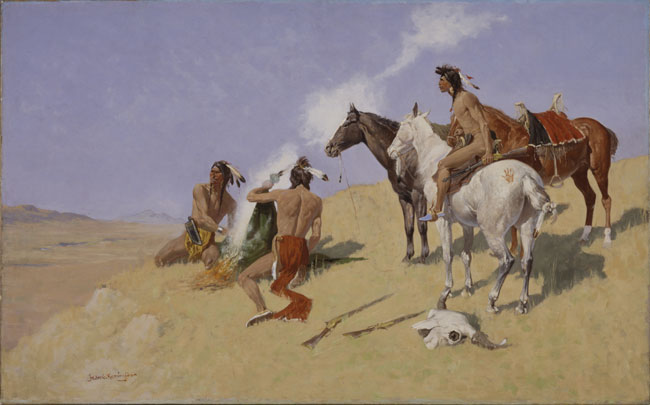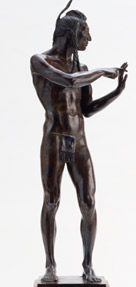The Wild West, its discovery and its conquest, its stubborn resistance and its dreamlike landscapes are some of the building blocks of American civilization. And with it, its grand and brutal history and the legend it became much before the territory was completely explored. Since the beginning of the XIXth century, artists have dedicated extraordinary works to it, which have remained practically unknown in Europe. Even in the U.S., this production is put to the side of art history and is hardly shown in the major, traditional museums. And yet, it is clear when we consider the amazing landscapes or the irresistible genre scenes in which the lonesome cowboy trudges along under the weight of his existential “malaise”, the XIXth century has left us some wonderful masterpieces.
Landscapes with cowboys and Indians
The poetry of a paradise-like territory (the large sites of Yosemite or Yellowstone, with their waterfalls, geysers and giant trees particularly well rendered by Bierstadt and Moran), inhabited by buffalo vowed to extinction (William Jacob Hays' melancholic landscapes) is confronted to the episodes of the Indian wars. These are depicted with a feeling of grandeur and an equal fascination for the two civilizations, confronted by Stanley, who represents the tragic disappearance of the Indian civilization on a backdrop of red skies, or Miller who was the first artist to join an exploration through the Rocky Mountains. Violence is always present and may be denounced or sublimated. Frederic Remington marks the apotheosis of a heroic and picturesque imagery, full of realistic flavor. The virtuoso immortalized up to the slightest nuance in gestures now considered «mythical», made by cowboys, military men, settlers and Indians as well as their horses. After him, a generation of brilliant illustrators (William R. Leigh, N. C. Wyeth) showed that the West remains a powerful source of inspiration for modern America, as is illustrated by the artist who closes the exhibition and who belongs completely to the XXth century: Maynard Dixon, between archaism and modernism, synthesizes all the approaches to the West to extract their magic.
FRAME, an efficient partner
The exhibition offers a choice based on criteria that are more aesthetic than historic, and a European outlook on a century of unlimited imagination, nourished above all by the fascination for fabulous landscapes that spread to the West of the Mississippi. It is made up essentially of collections from American museums belonging to the FRAME (or French Regional & American Museum Exchange, a model partnership between French and American regional museums, launched in 1999), among them the Denver Art Museum that holds an important department of «Western Art», as well as large, specialized institutions where emblematic works of art are kept. It will focus on showing how history and the imagination are often confused, and on underlining the major contribution by the artists to the creation of a true American, founding mythology, based on the ideal of freedom and adventure.
France and the Wild West
France has always been fascinated by the myth of the Wild West and the opportunities for artistic events have never lacked. One example is the presentation to king Louis-Philippe of George Catlin's Indian gallery (one can see other examples that followed with various artists, among them Delacroix) or the friendship between Rosa Bonheur and Buffalo Bill - whose Wild West Show was an extraordinary success in Europe. It is time that we rediscover, not only a human adventure of which movies alone cannot render the wealth and the complexity, but a major page in the history of art as well.
PUBLICATION :
La Mythologie de l'Ouest dans l'art américain, 1830-1940, catalogue directed by Laurent Salomé, published together with Silvana Editoriale (Milan), Musées de la Ville de Rouen, Musée des Beaux-Arts de Rennes, Musées de Marseille, 240 pages in color, 28 €.
Illustration : : Malvina Hoffmann, Indien Blackfoot parlant la langue des signes, 1930 © Cody, Buffalo Bill Historical Center
| 








